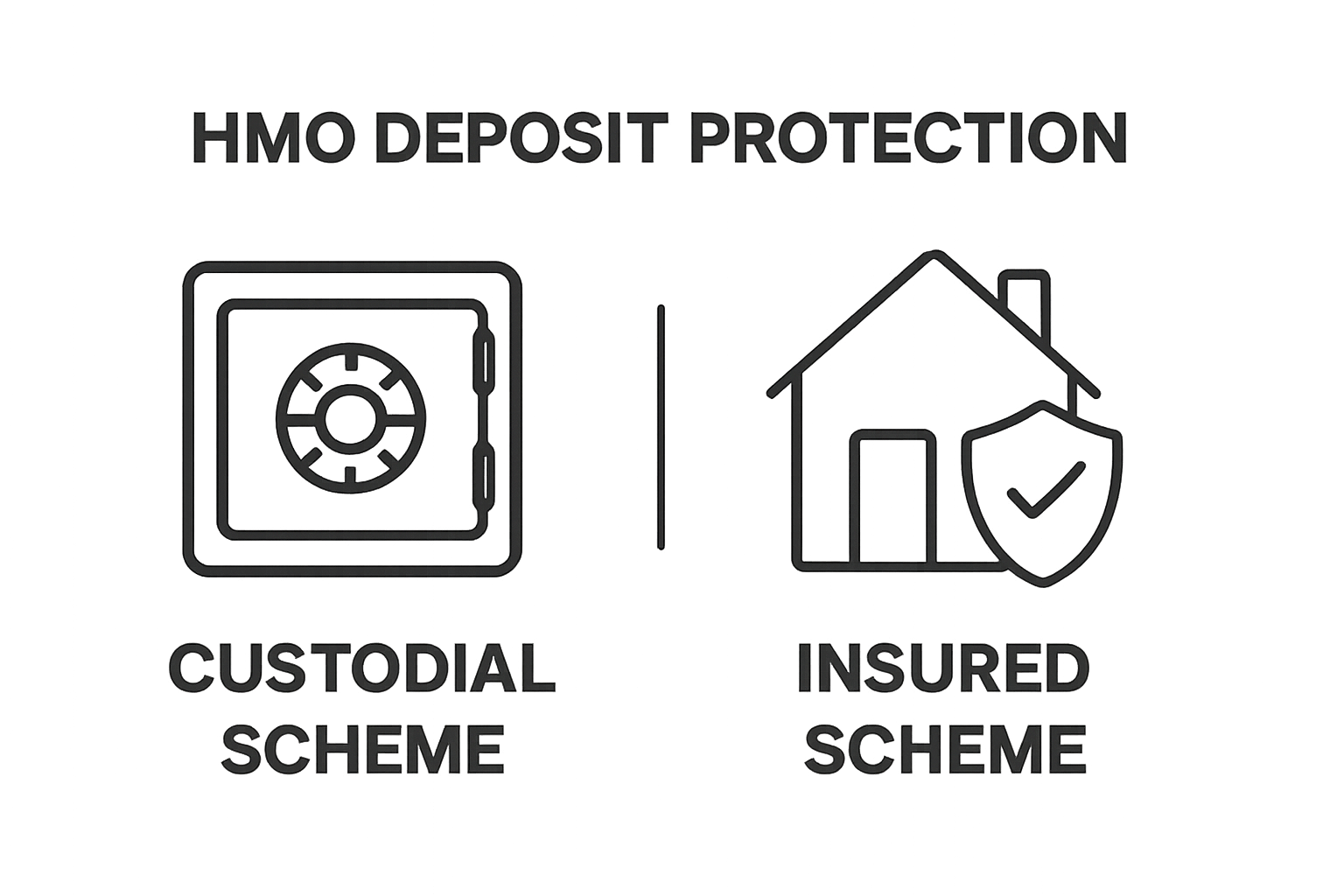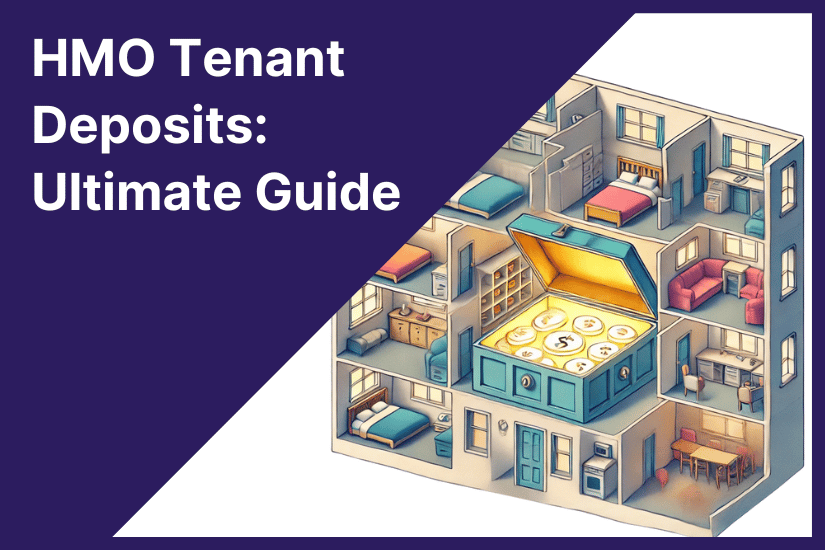HMO deposit protection is turning heads in the rental market. Landlords who fail to protect a tenant’s deposit could face fines of up to three times the original amount. Most people expect the rules to be a headache for tenants alone, but the real surprise is how these protections can save landlords huge legal troubles and financial loss. The secret is that both sides have more to gain than they realise.
Quick Summary
| Takeaway | Explanation |
|---|---|
| Landlords must protect deposits legally | Landlords must register tenant deposits with an approved scheme within 30 days of receipt, ensuring compliance with UK regulations. |
| Two deposit protection options exist | Landlords can choose between custodial schemes, which hold deposits, or insurance-based schemes, which allow landlords to retain deposits with coverage. |
| Proper documentation is essential | Accurate records of deposit transactions and property conditions are crucial for transparency and effective dispute resolution in HMO rentals. |
| Dispute resolution mechanisms help fairness | Independent third-party adjudication provides structured pathways for resolving conflicts over deposits, benefiting both landlords and tenants. |
| Non-compliance carries serious penalties | Failing to adhere to deposit protection laws can lead to severe financial consequences, including penalties of up to three times the deposit amount. |
Defining HMO Deposit Protection: What Is It?
HMO deposit protection represents a legal safeguard designed to protect tenants and landlords in Houses in Multiple Occupation (HMO) rental arrangements. Unlike standard residential tenancies, HMO properties involve multiple tenants occupying individual rooms within a single property, creating unique deposit management requirements.
The Legal Framework of Deposit Protection
In the UK, landlords managing HMO properties must comply with specific deposit protection regulations. According to government guidelines, these regulations mandate that landlords place tenant deposits into an approved protection scheme within 30 days of receiving the funds. This legal requirement ensures transparency and reduces potential disputes between tenants and property owners.
Key aspects of HMO deposit protection include:
- Mandatory registration with an authorized tenancy deposit protection scheme
- Providing tenants with detailed protection information
- Maintaining clear documentation of deposit transactions
- Ensuring fair dispute resolution mechanisms
Understanding Deposit Protection Mechanisms
Deposit protection schemes serve multiple critical functions in the HMO rental ecosystem. They provide a neutral third-party management system that safeguards tenant funds while offering landlords protection against potential property damage or rental agreement breaches.
When a tenant pays a deposit for an HMO room, the landlord must choose between two primary protection methods:
- Custodial Schemes: Where the deposit is held by the protection scheme itself
- Insurance-Based Schemes: Where the landlord retains the deposit but pays an insurance premium
These mechanisms ensure that tenant deposits are securely managed, with clear processes for return or potential deductions at the end of the tenancy. By implementing standardized protection protocols, HMO deposit protection creates a more transparent and fair rental environment for all parties involved.
The Importance of HMO Deposit Protection for Tenants and Landlords
HMO deposit protection serves as a critical mechanism that balances the financial interests and legal rights of both tenants and landlords in the complex rental ecosystem. By establishing transparent protocols for managing tenant deposits, this system creates a structured approach to preventing potential conflicts and ensuring fair treatment for all parties involved.
Financial Security and Risk Mitigation
According to government research, deposit protection schemes fundamentally transform the rental landscape by providing clear guidelines for financial accountability. For landlords, these mechanisms offer protection against potential property damage, while tenants receive assurance that their significant upfront financial investment remains secure.
Key financial protection elements include:
- Preventing arbitrary or unjustified deposit deductions
- Creating a standardized framework for damage assessment
- Establishing transparent dispute resolution processes
- Protecting both tenant and landlord financial interests
Legal Compliance and Dispute Resolution
The legal framework surrounding HMO deposit protection goes beyond mere financial management. These schemes create a robust system that encourages responsible tenancy practices while providing structured mechanisms for addressing potential disagreements. Learn more about HMO property management to understand the broader context of these regulations.
By mandating deposit protection, the legal system ensures that:
- Tenants have clear pathways to challenge unfair deposit withholdings
- Landlords maintain comprehensive documentation of property conditions
- Independent third-party adjudication becomes available in dispute scenarios
- Rental agreements become more transparent and accountable
Ultimately, HMO deposit protection represents more than a bureaucratic requirement. It is a sophisticated system designed to foster trust, minimize potential conflicts, and create a more professional, equitable rental environment for everyone involved in the HMO property market.
Understanding the Legal Framework of HMO Deposit Protection
The legal framework surrounding HMO deposit protection represents a comprehensive regulatory system designed to safeguard the financial interests of both tenants and landlords. This intricate framework establishes clear guidelines and mandatory requirements that transform deposit management from an informal practice to a structured, legally enforceable process.
Statutory Requirements and Compliance
According to government regulations, landlords managing HMO properties must adhere to specific legal obligations when handling tenant deposits. These requirements are not merely suggestions but legally binding mandates with significant consequences for non-compliance.
Key statutory requirements include:
- Registering deposits with an approved protection scheme within 30 days
- Providing tenants with comprehensive deposit protection information
- Maintaining accurate documentation of deposit transactions
- Ensuring transparent communication about deposit handling procedures
Penalties and Legal Consequences
The legal framework includes robust enforcement mechanisms to ensure landlords take deposit protection seriously. Learn more about dispute resolution services to understand the broader implications of these regulations.
Potential legal consequences for non-compliance encompass:
- Financial penalties of up to three times the original deposit amount
- Restrictions on serving eviction notices
- Potential court-mandated deposit repayments
- Loss of legal rights to recover property through standard eviction procedures
Moreover, the legal framework establishes clear dispute resolution pathways.
To clarify the potential consequences for landlords who fail to meet deposit protection requirements, the following table summarises key legal penalties and restrictions outlined in the article.
| Type of Non-Compliance | Legal Consequence | Financial Impact | Effect on Eviction Rights |
|---|---|---|---|
| Failure to protect deposit | Court-ordered penalty (up to 3x deposit) | Substantial potential fines | Cannot serve Section 21 eviction notice |
| Failure to provide information | Potential repayment of deposit to tenant | Loss of right to hold deposit | Risk of delayed or suspended eviction |
| Incomplete documentation | Weaker legal standing in disputes | Increased risk of tenant challenges | May impact outcome of possession claims |
| By mandating independent third-party adjudication and creating standardized assessment protocols, these regulations provide a structured mechanism for resolving potential conflicts between tenants and landlords, ultimately promoting fairness and transparency in the HMO rental market. |
How HMO Deposit Protection Works: Key Principles and Practices
HMO deposit protection operates as a sophisticated mechanism designed to create transparency, accountability, and financial security in multi-occupancy rental environments. By implementing structured protocols, this system ensures that both tenants and landlords have clear guidelines for managing substantial financial transactions associated with property rental.
Deposit Protection Scheme Mechanics
According to government regulations, HMO deposit protection involves registering tenant deposits with approved protection schemes within specific timeframes. These schemes provide two primary operational models that landlords can select based on their preferences and management strategies.
Key operational principles include:
- Mandatory registration within 30 days of receiving the deposit
- Providing comprehensive documentation to all tenants
- Maintaining transparent record-keeping processes
- Ensuring independent third-party oversight
Types of Protection Schemes
HMO deposit protection schemes are structured to offer flexibility while maintaining rigorous standards. Read our comprehensive guide on HMO property management to understand the nuanced approaches to deposit handling.
Two primary scheme types exist:
- Custodial Schemes: Where the protection scheme directly holds the deposit funds
- Insured Schemes: Where landlords retain the deposit but pay an insurance premium
Each scheme type offers distinct advantages, allowing landlords to select an approach that best aligns with their operational requirements and risk management strategies.
Below is a comparison table outlining the key features, responsibilities, and distinctions between custodial and insurance-based HMO deposit protection schemes to support landlords and tenants in selecting the most suitable approach.
| Protection Scheme Type | Who Holds the Deposit | Costs Involved | Typical Use Case | Oversight and Security |
|---|---|---|---|---|
| Custodial Scheme | Third-party scheme | No cost to landlord or tenant | Popular with landlords preferring independent | Scheme holds funds securely; neutral |
| third-party management | protection for both parties | |||
| Insurance-Based Scheme | Landlord | Landlord pays an insurance premium | Used by landlords who wish to retain deposit | Insurance policy covers deposit |
| but accept extra compliance responsibility | if disputes or failure to comply occur | |||
| Security for Tenants | Yes | Yes | Yes | Yes |
| Time to Register Deposit | 30 days | 30 days | 30 days | 30 days |
 The fundamental objective remains consistent: creating a secure, transparent framework that protects the financial interests of both tenants and property owners in the complex landscape of HMO rentals.
The fundamental objective remains consistent: creating a secure, transparent framework that protects the financial interests of both tenants and property owners in the complex landscape of HMO rentals.
Common Challenges and Considerations in HMO Deposit Protection
HMO deposit protection involves complex interactions between legal requirements, financial management, and interpersonal dynamics. Property owners and tenants frequently encounter nuanced scenarios that demand careful navigation and strategic understanding of deposit management protocols.
Navigating Deposit Dispute Resolution
According to government guidance, deposit disputes represent a significant challenge in HMO property management. These conflicts often arise from differing interpretations of property condition, damage assessment, and contractual obligations.

Common dispute triggers include:
- Disagreements about property wear and tear
- Inconsistent documentation of initial property conditions
- Subjective interpretations of cleaning standards
- Miscommunication regarding damage responsibility
Legal and Financial Risk Management
Landlords must implement robust strategies to mitigate potential legal and financial risks associated with deposit protection. Explore our comprehensive HMO property management resources to develop effective risk mitigation approaches.
Key risk management considerations encompass:
- Maintaining meticulous property condition records
- Conducting thorough tenant screening processes
- Developing clear, unambiguous tenancy agreements
- Creating comprehensive inventory documentation
Successful HMO deposit protection requires proactive communication, detailed documentation, and a nuanced understanding of legal frameworks. By anticipating potential challenges and implementing strategic management protocols, landlords can transform deposit protection from a potential source of conflict into a transparent, mutually beneficial process that protects the interests of both tenants and property owners.
Protect Your HMO Investment with Confidence
Worried about navigating HMO deposit protection and avoiding costly mistakes? The article highlights the complex legal requirements and financial risks faced by both landlords and tenants, from securing deposits in approved schemes to managing disputes fairly and in line with government guidelines. These challenges can feel overwhelming, especially when transparency and compliance are so critical in the HMO sector.

At agenthmo.co.uk, we make it simple to stay compliant and secure your investments. Our platform brings together expert HMO property management services, practical guidance on deposit protection, and reliable resources for both landlords and tenants. Join our community now to find all the support you need to safeguard your HMO property and make fully informed decisions. Take action today to ensure your deposit protection procedures stand up to scrutiny and keep your property business resilient.
Frequently Asked Questions
What is HMO deposit protection?
HMO deposit protection is a legal safeguard designed to protect tenants and landlords in Houses in Multiple Occupation (HMO) rental arrangements. It ensures that tenant deposits are securely managed and that there are clear protocols for return or deductions at the end of the tenancy.
How does HMO deposit protection work?
HMO deposit protection systems mandate landlords to register tenant deposits with an approved protection scheme within 30 days of receiving the funds. This can be either through custodial schemes, where the scheme holds the deposit, or insurance-based schemes, where landlords retain the deposit but pay an insurance premium.
What happens if a landlord fails to protect the deposit?
If a landlord fails to protect a tenant’s deposit within the required time frame, they may face legal penalties, including financial restitution of up to three times the deposit amount, restrictions on eviction notices, and a potential court order for deposit repayment.
How can tenants resolve disputes regarding their deposit?
Tenants can resolve disputes by following the dispute resolution processes set out by the deposit protection scheme. This involves providing clear documentation regarding the property’s condition and any disagreements about deductions. Independent third-party adjudication is available to ensure fair outcomes.


